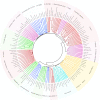Long-term dietary patterns are associated with pro-inflammatory and anti-inflammatory features of the gut microbiome
- PMID: 33811041
- PMCID: PMC8223641
- DOI: 10.1136/gutjnl-2020-322670
Long-term dietary patterns are associated with pro-inflammatory and anti-inflammatory features of the gut microbiome
Abstract
Objective: The microbiome directly affects the balance of pro-inflammatory and anti-inflammatory responses in the gut. As microbes thrive on dietary substrates, the question arises whether we can nourish an anti-inflammatory gut ecosystem. We aim to unravel interactions between diet, gut microbiota and their functional ability to induce intestinal inflammation.
Design: We investigated the relation between 173 dietary factors and the microbiome of 1425 individuals spanning four cohorts: Crohn's disease, ulcerative colitis, irritable bowel syndrome and the general population. Shotgun metagenomic sequencing was performed to profile gut microbial composition and function. Dietary intake was assessed through food frequency questionnaires. We performed unsupervised clustering to identify dietary patterns and microbial clusters. Associations between diet and microbial features were explored per cohort, followed by a meta-analysis and heterogeneity estimation.
Results: We identified 38 associations between dietary patterns and microbial clusters. Moreover, 61 individual foods and nutrients were associated with 61 species and 249 metabolic pathways in the meta-analysis across healthy individuals and patients with IBS, Crohn's disease and UC (false discovery rate<0.05). Processed foods and animal-derived foods were consistently associated with higher abundances of Firmicutes, Ruminococcus species of the Blautia genus and endotoxin synthesis pathways. The opposite was found for plant foods and fish, which were positively associated with short-chain fatty acid-producing commensals and pathways of nutrient metabolism.
Conclusion: We identified dietary patterns that consistently correlate with groups of bacteria with shared functional roles in both, health and disease. Moreover, specific foods and nutrients were associated with species known to infer mucosal protection and anti-inflammatory effects. We propose microbial mechanisms through which the diet affects inflammatory responses in the gut as a rationale for future intervention studies.
Keywords: diet; inflammatory bowel disease; intestinal microbiology; irritable bowel syndrome; meta-analysis.
© Author(s) (or their employer(s)) 2021. Re-use permitted under CC BY. Published by BMJ.
Conflict of interest statement
Competing interests: RKW acted as consultant for Takeda and received unrestricted research grants from Takeda and Johnson and Johnson pharmaceuticals and speaker fees from AbbVie, MSD, Olympus and AstraZeneca. FI received a speaker fee from AbbVie. GD reports speakers’ fees from Janssen Pharmaceuticals, Takeda and Pfizer. MC received invited speaking fees from Takeda. No disclosures: All other authors have nothing to disclose.
Figures




References
Publication types
MeSH terms
LinkOut - more resources
Full Text Sources
Other Literature Sources
Medical
Research Materials
